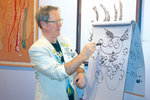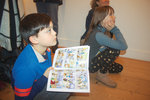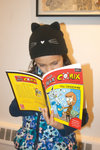When Port Townsend School of the Arts instructor Dana Sullivan launched the first volume of “Dead Max Comix” at the PSSA Grover Gallery with a book-signing and question-and-answer period …
This item is available in full to subscribers.
We have recently launched a new and improved website. To continue reading, you will need to either log into your subscriber account, or purchase a new subscription.
If you had an active account on our previous website, then you have an account here. Simply reset your password to regain access to your account.
If you did not have an account on our previous website, but are a current print subscriber, click here to set up your website account.
Otherwise, click here to view your options for subscribing.
* Having trouble? Call our circulation department at 360-385-2900, or email our support.
Please log in to continue |
|





When Port Townsend School of the Arts instructor Dana Sullivan launched the first volume of “Dead Max Comix” at the PSSA Grover Gallery with a book-signing and question-and-answer period on Jan. 23, he found he had a live Max in the audience.
Sullivan’s graphic novel stars a dog named Max who dies, is cremated and comes back as a ghost to guide his young owner, Derrick, through the trials and travails of middle school, and 8-year-old Max Galligan-Hong was one of the young readers on hand at the Grover Gallery for Sullivan’s talk.
Max’s father, Mike Galligan, already knew Sullivan from a writing group they attend together, but the affinity that Max and his 5-year-old sister Mei Mei demonstrated for “Dead Max Comix” had nothing to do with their father’s friendship with the book’s creator.
“We have two dogs,” said Max, who attends after-school art classes with his sister, because of how much they like drawing and cartoons. “Max is a funny dog.”
Young Max was so engrossed in the adventures of “Dead Max” he could barely look up from the pages of the graphic novel, even when Sullivan later addressed the audience as a whole.
Kaylee Klebanow, 9, is another young reader who was recruited into being a “Dead Max” fan. Like the Galligan-Hong siblings, she loves graphic novels in general.
“I like that they have so many pictures,” Klebanow said. “It makes them easier to read.”
Klebanow also enjoys drawing, although she told Sullivan that she prefers to draw “imaginary things” that are “not so much realistic.”
When Sullivan addressed his audience of kids and adults alike, he asked how many people like to write or draw, and quickly amended his own question about who in the crowd was a writer by saying, “Who isn’t a writer in Port Townsend?”
From there, Sullivan detailed the origins of “Dead Max Comix,” recalling how he’d promised his son that, when he turned 10 years old, if they had a house with a fenced-in yard, he could get his own dog. The dog the younger Sullivan chose was a Blue Heeler whom he named Max, which celebrated 15 birthdays before passing away in 2009.
“He became my muse,” Sullivan said, holding up an urn of ashes that said “Max,” as his wife drew laughter by adding, “But his soulmate of 40 years, I’m not his muse,” to which Sullivan replied, “At least you’re not in an urn.”
Max the dog first surfaced in Sullivan’s writing as part of his submission for National Novel Writing Month in 2011, which led his agent to tell him, “This reads like a middle-aged man writing for middle-grade kids. Why don’t you make this a graphic novel instead?”
Sullivan began submitting “Dead Max Comix” to publishers in 2016, and received 77 rejections before Red Chair Press picked it up in 2018, and they asked if “Dead Max Comix” could be turned into a four-volume set of graphic novels.
“My plan is for book four to have the school goldfish get turned into zombie piranhas,” Sullivan said. “In the meantime, the first book is only just coming out now, which shows that writing is a very straightforward and lucrative process,” he added with deliberate irony.
Although “Dead Max” is based on his son’s dog, his seventh-grade protagonist Derrick is based on his younger self, as he demonstrated by holding a drawing of Derrick up next to a photo of himself at that same age.
“Middle school is a tough time,” Sullivan said. “Everything is changing, especially yourself. I remember there were teachers who offered to talk to us, and at the time, I laughed at that, but looking back, I had some amazing teachers who were looking out for me, so I wanted the kids who read these books to know there are adults out there who they can trust.”
By contrast, Sullivan’s agent advised him to follow a simpler ethos: “If you want to send a message, use Western Union. Just make them laugh.”
To that end, when Sullivan demonstrated how he creates art — by drawing with waterproof markers over rough pencil sketches, then erasing the pencils and adding watercolor paints — he acknowledged that he’s less concerned with capturing realism than emotion in his figures.
“I try to draw fast,” Sullivan said. “By making Max’s collar black, I must have saved 28 minutes on the whole first book. Max is easy to draw. Other characters have details like fingers.”
Sullivan explained that a typical children’s picture book numbers 32 pages, with one illustration for each page or spread of pages, his “Dead Max Comix” graphic novels have tended to number 64 pages, with anywhere between half a dozen to a dozen illustrations per page.
“It helps you edit down your writing, when you have to fit everything into these little bubbles,” Sullivan said. “It tightens your prose. And when I see graphic novels that have different credits for colorists and inkers, I always think, ‘Who are all these people?’ I couldn’t afford that.”
While the first book of “Dead Max Comix” is available for purchase, Sullivan confirmed the second book is “in the can, or in the urn, I should say,” while he’s still sketching out the third volume.
Sullivan credited Hilary Verheggen, youth services manager for the Port Townsend Public Library, and Joy Wentzel, librarian for the entire Port Townsend School District, with providing invaluable feedback as he was working on “Dead Max Comix.”
Wentzel, in turn praised Sullivan for donating not only a number of his books, but also free drawing lessons to students at the district’s elementary, middle and high schools.
“What I learned is that they’re all better drawers than I am,” Sullivan said.
Sullivan concluded his remarks by exhorting his audience to hold their pencils (or other writing implements) high, as they repeated his pledge: “I promise to keep writing and drawing my stories, because no one else can tell them like I can. Write on!”